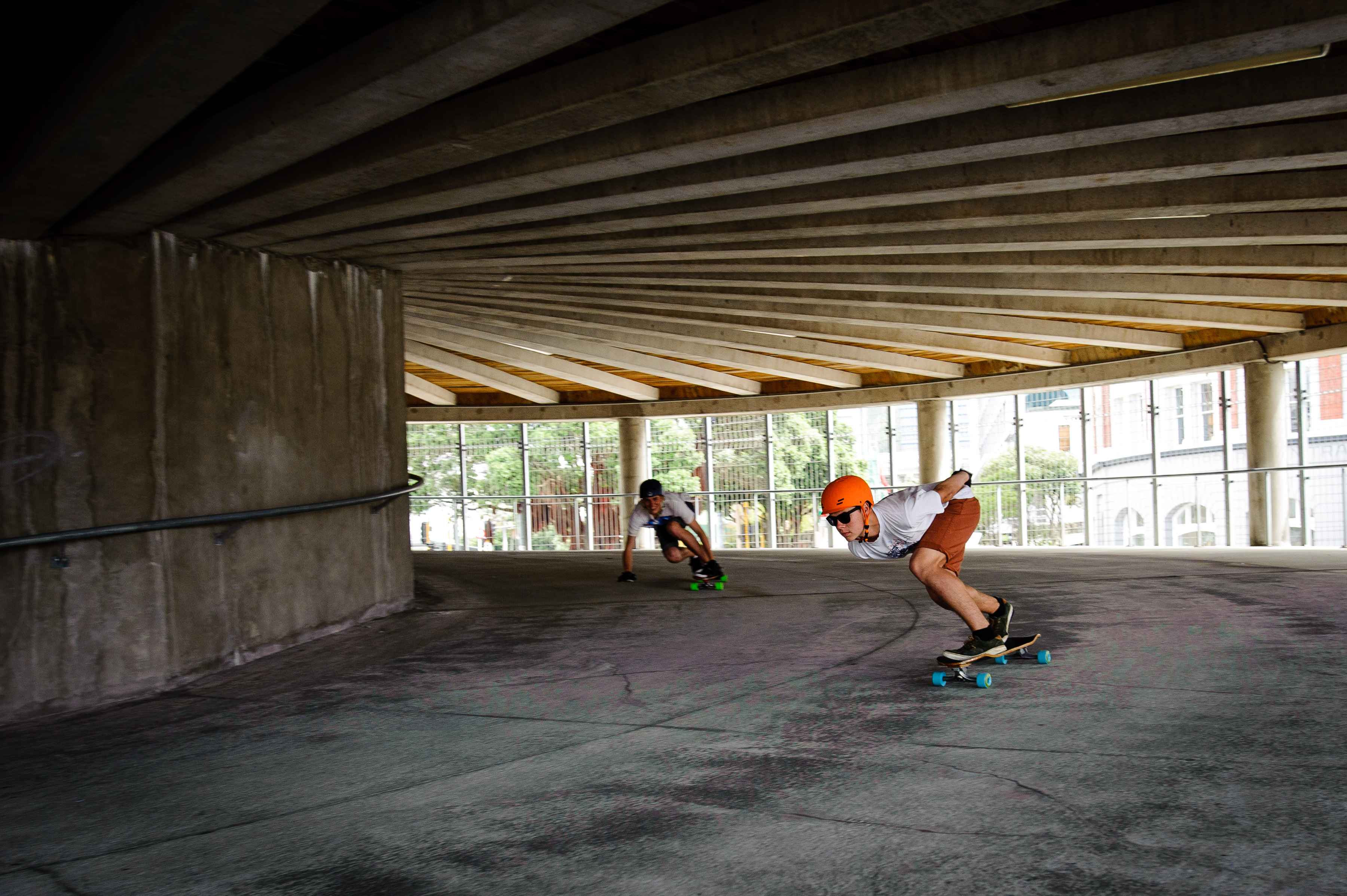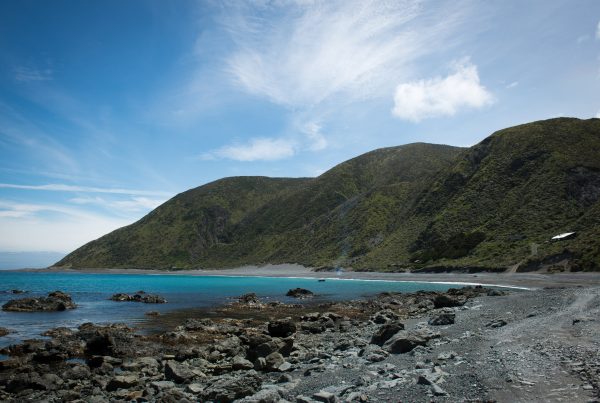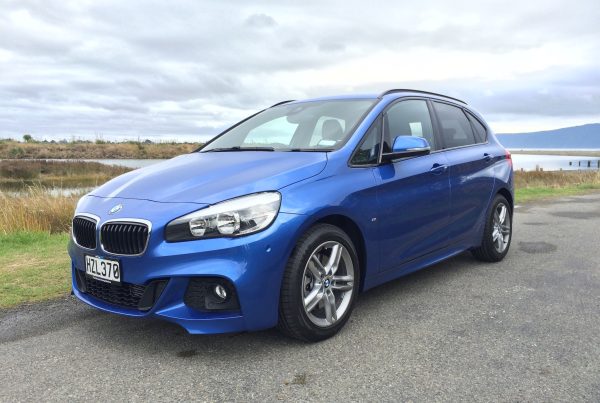 Longboarding
Longboarding
When Paddy Howard came off his longboard at 60km/h he didn’t think for a moment that he should find a more peaceful recreational pursuit. Even bouncing off the slightly uneven path near Ngauranga Gorge and badly scraping his knee didn’t hinder his desire to come back and continue ‘bombing’ hills (to bomb = to race to the end).
It doesn’t have to be so bumpy. Wellington has an abundance of areas where the pavement is smooth and provides a concrete playground. There are hotspots in Aro Valley and — if you are looking for more of a challenge — Brooklyn, near the upper end of Ashton Fitchett Drive, close to the wind turbine. The safest areas to ride are non-intersecting roads, and most riders choose to go out at night when there is less traffic.
Chris Sanderson, a member of the Wellington Longboard Association (WLA), says that “90 percent of people don’t know that I’m there on the road, and the other ten percent are out to get me”. He is adamant that he has rights, and that boarders will be hurt if people aren’t careful. “We just hope people will do the right thing.”
In 2014, 15 and 16 March marked the annual Wind Turbine Race. Starting just metres from the Brooklyn wind turbine, the event saw riders navigating a 1km time-trial run. Conditions on the day made for some impressive slides, meaning that riders had to be careful navigating corners. Helmets, gloves and kneepads are obvious safety necessities, as riders reach speeds of over 50 km/h — the weekend’s quickest time was recorded at 1 minute 13 seconds. Assistance from ambulance crews is also on hand, which is crucial as one participant dislocated his shoulder during a run.
Typically, riders arrange to meet up on Sundays via the WLA Facebook page, often at the ‘spiral’ linking Thorndon Quay and the Fran Wilde Walk approach to Westpac Stadium near the Wellington Railway Station. Newbies can borrow a board and start with the basics.
WLA’s sponsorship expert, Rachel London, encourages everyone to give longboarding a go. With one of the group’s oldest members being 57 years of age, what excuse have you got?


Slacklining
A web of lines forms across Aro Park; an unusual sight to see on a Sunday afternoon. Is it tightrope walking? Not quite. It’s something a little more dynamic: slacklining.
The spo
FishHead photographer Mark Tantrum tried it out, and found initially that maintaining his balance was a real challenge. “If you are losing your balance, you move your hands as opposed to your feet, in order to regain balance. The trick is also to zone out and focus on a reference point,” says Plain. A reference point becomes harder to focus on when you are highlining, for example, as you are often positioned above water moving below you, and your balance can be thrown off.
Morgan says that his line is no more than “a fancy truck tie-down” that set him back a modest $80 on Trade Me, although Gibbon Slacklines is considered the go-to company for anything slackline related. The company also provide tree protectors, which are crucial when the lines are set up around trees, as in Aro Park. The protectors prevent rings forming around the trees due to wear and tear.
Gibbon Slacklines have a risk assessment form outlining what slackliners should consider before each walk. A line for learners, they suggest, should be no more than 50cm off the ground. Safety pads are also recommended, to minimise risk of injury.
The Wellington Slackline Collective is in the process of becoming an incorporated society, which will allow them to fundraise for equipment and events, and they successfully ran their own slackline festival at Frank Kitts Park last year.
Les Mills personal trainer Luis Carvalho has been looking into the health benefits of slacklining. He told FishHead that research carried out by Australian Physiotherapy Association sports therapist Philip Gabel describes slacklining as “a novel method to enhance quadriceps recruitment, core strength and balance control”. Slackliners consider the sport to be a less strenuous exercise option for people suffering from knee injuries — all the more reason to ‘slack off’, as they say!
Kitesurfing/kiteboarding
When the winds at Lyall Bay reach gale force, that’s when the ‘Best Kiteboarding’ flag is raised. The flag signals where to meet, and on that stormy day I lost most of the circulation in my fingertips!

Gabe Laing-Aiken has been kiteboarding for three years. He started out at Raglan Beach when he was 12 years old, and soon came up to speed. Today, he sports a ‘twin tip’ — a board that allows him to ride backwards and forwards on the waves.
The idea is that the windier the conditions, the smaller the kite you use, making Aiken’s 6m kite ideal for the 35-knot winds that rattle through Lyall Bay. Stormy weather doesn’t often deter kitesurfer Jamie MacDonald, although if it is over 50 knots, he says he won’t go out. “The trick to handling the wind is to keep the kite low when you are heading out. If you come into danger, you can pull the safety release that is clipped onto your waist, linking up to the kite, which will turn into a flag when the release is pulled.”
Learners should not, however, throw caution to the wind. A sign on the beachfront states: “Lyall Bay is not for beginners, and is not appropriate for teaching.” For newbies, the best places to go include Foxton Beach and the Kapiti Coast, as city beaches are generally gustier.
In terms of future development, riders are hoping that the wake park proposed for Aotea Lagoon in Porirua will go ahead, allowing them to frequent the area in the summertime. But first, it has to get through a consent process with Porirua City Council and the regional council. Here’s hoping!
Downhill mountain biking

Mountain biking is a popular pastime for many Wellingtonians, but you may not be aware of some options, including Bike Wellington’s skills courses and tours around the hills of the city, with qualified guides.

Ashley is also the co-founder of Revolve Cycling Club — a woman-only club that was established five years ago. The ladies have their own Super V race day at Polhill Reserve in Aro Valley. This is the women’s version of the Super D format, a downhill cross-country race.
The Wellington Mountain Bike Club, a non-profit organisation run by volunteers, holds events year-round round, including the cSixx Mt Vic Super D earlier this year.
Another popular area for biking is Rata Ridge in Wainuiomata. Rider Jack Whattam says “the track is far less groomed than most, which makes for fun riding. The area would be a Grade 4, which involves quite a technical ride.” If you are looking for a less technical — and more child-friendly — track, try the South Coast Kids Track in Island Bay. This track is not steep and is wider than most, making it ideal for learners. Whattam is involved in trail-building at Makara Peak and in the past has been involved with trail-building in Chile through New Zealand Trail Solutions.
Volunteer-led trail projects can apply to Trail Fund NZ for grants to help build new trails or work on existing trails. A tonne of opportunities are on offer, and if you can navigate a bike with dual suspension down a hill, then you are halfway there!


 Longboarding
Longboarding








